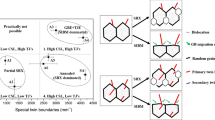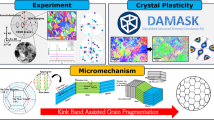Abstract
Modification in grain boundary character distribution has been known to improve the functional and mechanical properties of low stacking fault energy, face centered cubic materials. In this work, thermomechanical processing has been employed on nickel alloy using iterative and single-step, non-iterative routes to gain an insight into the role of processing path on the generation of low-Σ coincidence site lattice (CSL) boundaries. A low amount of strain (~4 %) has been used in iterative processing in order to obtain CSL boundaries with less deviation. Evolution of Σ1 and Σ3 boundaries showed different trends during iterative and non-iterative processing. Also, iterative processing resulted in low-Σ CSL fraction (Σ ≤ 29) as high as 0.9 consisting of significant fraction from both Σ1 and Σ3 boundaries. Non-iterative processing yielded low-Σ CSL fraction of 0.73 but with significant contribution only from Σ3 boundaries.







Similar content being viewed by others
References
Watanabe T, Res Mech 11 (1984) 47.
Watanabe T, and Tsurekawa S, Acta Mater 47 (1999) 4171.
Aust K, Can Metall Q 33 (1994) 265.
Brokman A, and Balluffi R W, Acta Metall 29 (1981) 1703.
Kronberg M, and Wilson F, AIME Trans 185 (1949) 501.
Randle V, The Role of the Coincidence Site Lattice in Grain Boundary Engineering, Institute of Materials, London (1996).
Randle V, and Brown A, Philos Mag A 59 (1989) 1075.
Schwartz A J, Kumar M, and King W E, MRS Proceedings, vol 586, Cambridge University Press, Cambridge (1999), p 3.
Randle V, and Owen G, Acta Mater 54 (2006) 1777.
Thomson C, and Randle V, Acta Mater 45 (1997) 4909.
Palumbo G, Lehockey E, and Lin P, JOM 50 (1998) 40.
Gao Y, Ritchie R, Kumar M, and Nalla R, Metall Mater Trans A 36 (2005) 3325.
Field D, and Adams B, Acta Metall Mater 40 (1992) 1145.
Lehockey E, Palumbo G, Lin P, and Brennenstuhl A, Scripta Mater 36 (1997) 1211.
Miyamoto H, Ikeuchi K, and Mimaki T, Scripta Mater 50 (2004) 1417.
Aust K, Erb U, and Palumbo G, Mater Sci Eng A 176 (1994) 329.
Palumbo G, King P, Aust K, Erb U, and Lichtenberger P, Scr Metall Mater 25 (1991) 1775.
Lehockey E, Palumbo G, and Lin P, Scr Mater 39 (1998) 353.
Watanabe T, Fujii H, Oikawa H, and Arai K, Acta Metall 37 (1989) 941.
Inconel E L, Alloys 4 (1999) 600.
Crum J R, Major Applications and Corrosion Performance of Nickel Alloys, vol 13, Corrosion. ASM Handbook (1992).
Friend W Z, Corrosion of Nickel and Nickel-Base Alloys, Wiley, New York (1980).
Cheng C F, J Nucl Mater 57 (1975) 11.
Lin H, and Pope D P, Acta Metall Mater 41 (1993) 553.
Gertsman V Y, and Bruemmer S M, Acta Mater 49 (2001) 1589.
Palumbo G, and Aust K, Acta Metall Mater 38 (1990) 2343.
Hasson G, Boos J Y, Herbeuval I, Biscondi M, and Goux C, Surf Sci 31 (1972) 115.
Winning M, Rollett A, Gottstein G, Srolovitz D, Lim A, and Shvindlerman L S, Philos Mag 90 (2010) 3107.
Lin P, Palumbo G, Erb U, and Aust K, Scr Metall Mater 33 (1995) 1387.
Kumar M, King W E, and Schwartz A J, Acta Mater 48 (2000) 2081.
Shimada M, Kokawa H, Wang Z, Sato Y, and Karibe I, Acta Mater 50 (2002) 2331.
Qian M, and Lippold J, Acta Mater 51 (2003) 3351.
Kumar M, Schwartz A J, and King W E, in Proceedings of the International Conference on Texture of Materials (1999), p 9.
Lim L, and Raj R, Acta Metall 32 (1984) 1177.
Brandon D, Acta Metall 14 (1966) 1479.
Sutton A P, and Balluffi R W, Interfaces in Crystalline Materials, Oxford Science Publications Clarendon Press, Oxford (1995).
Acknowledgments
This work was supported by Indian Institute of Technology Kanpur under initiation Grant No. INI-IITK-MET-20110158. The authors are also grateful to the reviewers for their helpful comments in improving the quality of the manuscript.
Author information
Authors and Affiliations
Corresponding author
Rights and permissions
About this article
Cite this article
Vaid, A., Mittal, K., Sahu, S. et al. Controlled Evolution of Coincidence Site Lattice Related Grain Boundaries. Trans Indian Inst Met 69, 1745–1753 (2016). https://doi.org/10.1007/s12666-016-0834-7
Received:
Accepted:
Published:
Issue Date:
DOI: https://doi.org/10.1007/s12666-016-0834-7




